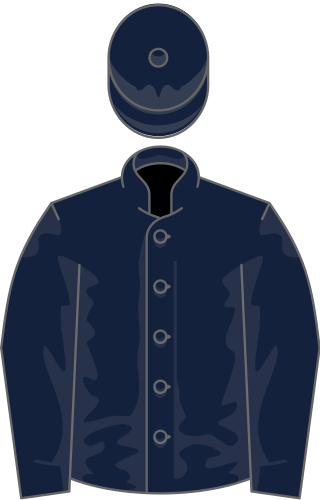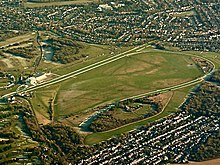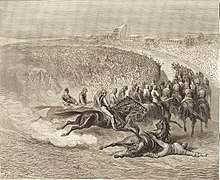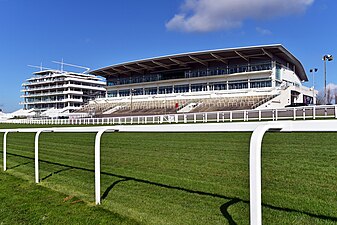
The Derby Stakes, also known as the Derby or the Epsom Derby, is a Group 1 flat horse race in England open to three-year-old colts and fillies. It is run at Epsom Downs Racecourse in Surrey on the first Saturday of June each year, over a distance of one mile, four furlongs and 10 yards, or about 1½ miles. It was first run in 1780.

The Oaks Stakes is a Group 1 flat horse race in Great Britain open to three-year-old fillies. It is run at Epsom Downs over a distance of 1 mile, 4 furlongs and 6 yards, about 1½ miles, and it is scheduled to take place each year in late May or early June. It is the second-oldest of the five Classic races, after the St Leger. Officially the Betfred Oaks, it is also popularly known as simply The Oaks. It has increasingly come to be referred to as the Epsom Oaks in both the UK and overseas countries, although 'Epsom' is not part of the official title of the race.)

Ouija Board was a British Thoroughbred racehorse. She was owned by Edward Stanley, 19th Earl of Derby, and trained by Ed Dunlop and Chris Hinson. In a career spanning four seasons, she won 10 of her 22 races, seven of them Group 1s, including the Oaks in 2004 and the Hong Kong Vase in 2005, while amassing over £3 million in prize money. In 2004, she won the Breeders' Cup Filly & Mare Turf and came second to Intercontinental the following year. In 2006, she regained her crown, becoming the second horse to win Breeders' Cup races in non-consecutive years.

Authorized is an Irish-bred and British-trained Thoroughbred racehorse, winner of the 2007 Epsom Derby.

Time Charter was an Irish-bred, British-trained Thoroughbred racehorse and broodmare who won several major middle-distance races between 1982 and 1984. After winning twice as a two-year-old in 1981, she developed into a classic filly in the following year, finishing second in the 1000 Guineas before winning The Oaks in record time. Later that year she won the Sun Chariot Stakes before beating a field of colts and older horses by seven lengths in the Champion Stakes. As a four-year-old she won England's premier weight-for-age race, the King George VI and Queen Elizabeth Stakes and successfully conceded seven pounds to the outstanding French filly All Along in the Prix Foy. In 1984 she recorded an impressive four length victory in the Coronation Cup and was retired from racing at the end of the year having won nine of her twenty races. She later became a very successful broodmare.
Shadayid was an American-bred, British-trained Thoroughbred racehorse and broodmare. In a racing career which lasted from June 1990 to November 1991 she ran eleven times winning five races and being placed five times. Shadayid was one of the leading two-year-old fillies in Europe in 1990, winning all three of her races including the Group One Prix Marcel Boussac at the Longchamp. After winning the Fred Darling Stakes on her three-year-old debut, Shadayid took her unbeaten run to five by winning the Classic 1000 Guineas at Newmarket. Although she never won again, she finished second in the Coronation Stakes and the Sussex Stakes and third in the Haydock Sprint Cup and the Queen Elizabeth II Stakes. Shadayid was retired from racing to become a broodmare at the end of her three-year-old season after finishing seventh in the Breeders' Cup Mile.
Sun Stream was a British Thoroughbred racehorse and broodmare, best known for winning two Classics in 1945. The filly won five times from seven races in a track career which lasted from spring 1944 until June 1945. As a two-year-old in 1944 she won three races including the Queen Mary Stakes. After being beaten on her three-year-old debut she won the 1000 Guineas over one mile at Newmarket and a substitute Oaks over one and a half miles at the same course a month later. After her second classic win she was retired to stud, where her record as a broodmare was disappointing.

Busybody (1881–1899), was a British Thoroughbred racehorse and broodmare who won two British Classic Races in 1884. In a racing career which lasted from September 1883 until May 1884 she ran six times and won five races. As a two-year-old in 1883 she won her first three races including the Middle Park Plate and the Great Challenge Stakes before sustaining her only defeat when conceding weight to the winner Queen Adelaide in the Dewhurst Stakes. As a three-year-old she won the 1000 Guineas over one mile at Newmarket and The Oaks over one and a half miles at Epsom Downs Racecourse a month later. She was then retired to stud where she became a successful broodmare.

Meteora (1802–1821) was a British Thoroughbred racehorse and broodmare who won the classic Oaks Stakes at Epsom Downs Racecourse in 1805. In a racing career which began with her win in the Oaks on 31 May 1805 and lasted until July 1810 she ran thirty-six timeas and won twenty-four races. She defeated the Derby winner Cardinal Beaufort and the St Leger winner Staveley in match races and won many other important races of the era including the Stamford Gold Cup, the Oatlands Stakes (twice), the Audley End Stakes, the Somerset Stakes and the Brighton Gold Cup. Many of her defeats occurred when she was carrying large weights in handicap races.

Diadem (1914–1931) was a British Thoroughbred racehorse who won the 1000 Guineas in 1917. She went on to become a top sprinter, recording two victories in both the King's Stand Stakes and the July Cup. In total she won 24 of her 39 races. Diadem was bred and owned by Edgar Vincent, 1st Viscount D'Abernon, and trained by George Lambton. The Diadem Stakes at Ascot Racecourse was named after her.

Queen of Trumps (1832–1843) was a British thoroughbred racehorse and broodmare best known for winning the classic Oaks and St Leger Stakes in 1835, becoming the first horse to win both races. In a racing career which lasted from October 1834 until October 1836 she won ten of her eleven races. After being successful in her only race as a two-year-old, she defeated the 1000 Guineas winner Preserve in the Oaks on her three-year-old debut. Later that year she started as favourite for the St Leger and won from a field which included Preserve and The Derby winner Mundig. Queen of Trumps sustained her only defeat a few days later when she was attacked by a dog in the closing stages of the Scarborough Stakes. She was retired to stud after winning all four of her races in 1836. Queen of Trumps died in 1843 at the age of eleven. She was described by a contemporary writer as "certainly the most extraordinary mare these our days have seen".

Sallust (1969–1987) was an Irish-bred British-trained Thoroughbred racehorse and sire. He showed good form as a two-year-old in 1971, winning two of his five races including the Richmond Stakes, but appeared to be just below the highest class. He ran poorly on his three-year-old debut but then won the Diomed Stakes, Prix de la Porte Maillot, Sussex Stakes, Goodwood Mile and Prix du Moulin. By decisively defeating opponents such as High Top and Lyphard he established himself as the best specialist miler in Europe and was rated the best three-year-old of 1972 by Timeform. He returned to Ireland for his stud career and had some success as a sire of winners.
Fairy Footsteps was a British Thoroughbred racehorse and broodmare best known for winning the classic 1000 Guineas in 1981. She showed promise in her first two races as a two-year-old before establishing herself as one of the best fillies of her generation with an emphatic win in the Waterford Candelabra Stakes. In the spring of 1981 she was heavily backed for the 1000 Guineas before and after a win in the Nell Gwyn Stakes. She won the 1000 Guineas by leading all the way and was considered highly likely to follow up with a win in the Epsom Oaks but was retired after a disappointing defeat in the Musidora Stakes. She had some success as a broodmare.
Roland Gardens was a British Thoroughbred racehorse and sire best known for winning the classic 2000 Guineas in 1978. During a racing career which lasted from 1977 until 1979 he ran sixteen times and won four races. As a two-year-old he showed moderate form in his first three races before being disqualified after passing the post first in the Horris Hill Stakes. In the following spring he won the Blue Riband Trial Stakes before recording a 28/1 upset victory in the 2000 Guineas. He was beaten in his remaining five races that year and won once in four starts as a four-year-old. He later stood as a breeding stallion in South Africa where he had some success as a sire of winners.
Roseate Tern was a British Thoroughbred racehorse and broodmare. In her first seven races she failed to win but was placed in several major races including the May Hill Stakes, Epsom Oaks and Ribblesdale Stakes. She then recorded her first win in the Lancashire Oaks before recording her biggest win in the Yorkshire Oaks and then finished third in the St Leger. She won the Jockey Club Stakes as a four-year-old and later had some success as a broodmare. She was involved in two of the major racing controversies of the late 1980s: the dismissal of Dick Hern and the Aga Khan's boycott of British racing.

Minding is a champion Irish Thoroughbred racehorse who was the 2016 European Horse of the Year after winning the Epsom Oaks, 1000 Guineas, and Queen Elizabeth II Stakes.

Together Forever is an Irish Thoroughbred racehorse. After being beaten in her first three races she showed significant progress in the autumn of her two-year-old season winning three races of increasing prestige. She followed up a win in a maiden race with a victory in the Listed Staffordstown Stud Stakes before ending her season by taking the Group One Fillies' Mile. She failed to win as a three-year-old but finished second in the Musidora Stakes and fourth in the Irish Oaks.

Enable is a champion British Thoroughbred racehorse who won 15 of her 19 races, including 11 Group One races. Her biggest wins include the Breeders' Cup Turf, Prix de l'Arc de Triomphe, Epsom Oaks, Irish Oaks, King George VI and Queen Elizabeth Stakes, Eclipse Stakes and Yorkshire Oaks. Enable was the 2017 and 2019 European Horse of the Year.
Bracelet is an Irish Thoroughbred racehorse and broodmare. She won the second of her two starts as a two-year-old in 2013 and developed into a top-class filly in the following year, taking the Leopardstown 1,000 Guineas Trial and Ribblesdale Stakes. She recorded her biggest victory on her sixth and final appearance when she won the Irish Oaks. She was retired from racing at the end of the season and became a broodmare for the Coolmore Stud.

Our Lassie was a British Thoroughbred racehorse and broodmare. She was a very good performer as a juvenile in 1902 when she won the Sandown Produce Stakes and was placed in her other three starts. In the following year she failed in the Lincoln Handicap but the recorded a decisive win in the Oaks Stakes. She failed to win or place in four subsequent races and was retired from racing at the end of 1904. As a broodmare she produced a few winners but had her biggest impact on the future of Thoroughbred racing through her unraced daughter Lady Brilliant.




















